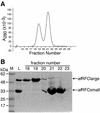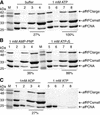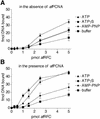Biochemical characterisation of the clamp/clamp loader proteins from the euryarchaeon Archaeoglobus fulgidus
- PMID: 12384579
- PMCID: PMC137147
- DOI: 10.1093/nar/gkf584
Biochemical characterisation of the clamp/clamp loader proteins from the euryarchaeon Archaeoglobus fulgidus
Abstract
Replicative polymerases of eukaryotes, prokaryotes and archaea obtain processivity using ring-shaped DNA sliding clamps that are loaded onto DNA by clamp loaders [replication factor C (RFC) in eukaryotes]. In this study, we cloned the two genes for the subunits of the RFC homologue of the euryarchaeon Archaeoglobus fulgidus. The proteins were expressed and purified from Escherichia coli both individually and as a complex. The afRFC subunits form a heteropentameric complex consisting of one copy of the large subunit and four copies of the small subunits. To analyse the functionality of afRFC, we also expressed the A.fulgidus PCNA homologue and a type B polymerase (PolB1) in E.coli. In primer extension assays, afRFC stimulated the processivity of afPolB1 in afPCNA-dependent reactions. Although the afRFC complex showed significant DNA-dependent ATPase activity, which could be further stimulated by afPCNA, neither of the isolated afRFC subunits showed this activity. However, both the large and small afRFC subunits showed interaction with afPCNA. Furthermore, we demonstrate that ATP binding, but not hydrolysis, is needed to stimulate interactions of the afRFC complex with afPCNA and DNA.
Figures







Similar articles
-
Distinct roles for ATP binding and hydrolysis at individual subunits of an archaeal clamp loader.EMBO J. 2004 Mar 24;23(6):1360-71. doi: 10.1038/sj.emboj.7600130. Epub 2004 Mar 11. EMBO J. 2004. PMID: 15014449 Free PMC article.
-
Replication factor C from the hyperthermophilic archaeon Pyrococcus abyssi does not need ATP hydrolysis for clamp-loading and contains a functionally conserved RFC PCNA-binding domain.J Mol Biol. 2002 Nov 8;323(5):795-810. doi: 10.1016/s0022-2836(02)01028-8. J Mol Biol. 2002. PMID: 12417194
-
Biochemical characterization of a clamp-loader complex homologous to eukaryotic replication factor C from the hyperthermophilic archaeon Sulfolobus solfataricus.J Mol Biol. 2000 Aug 4;301(1):61-73. doi: 10.1006/jmbi.2000.3964. J Mol Biol. 2000. PMID: 10926493
-
The PCNA-RFC families of DNA clamps and clamp loaders.Prog Nucleic Acid Res Mol Biol. 2004;78:227-60. doi: 10.1016/S0079-6603(04)78006-X. Prog Nucleic Acid Res Mol Biol. 2004. PMID: 15210332 Review.
-
The RFC clamp loader: structure and function.Subcell Biochem. 2012;62:259-79. doi: 10.1007/978-94-007-4572-8_14. Subcell Biochem. 2012. PMID: 22918590 Free PMC article. Review.
Cited by
-
Sulfolobus replication factor C stimulates the activity of DNA polymerase B1.J Bacteriol. 2014 Jul;196(13):2367-75. doi: 10.1128/JB.01552-14. Epub 2014 Apr 18. J Bacteriol. 2014. PMID: 24748616 Free PMC article.
-
Diversity of the DNA replication system in the Archaea domain.Archaea. 2014 Mar 26;2014:675946. doi: 10.1155/2014/675946. eCollection 2014. Archaea. 2014. PMID: 24790526 Free PMC article. Review.
-
Dual functions, clamp opening and primer-template recognition, define a key clamp loader subunit.J Mol Biol. 2004 Oct 1;342(5):1457-69. doi: 10.1016/j.jmb.2004.07.097. J Mol Biol. 2004. PMID: 15364574 Free PMC article.
-
A small protein inhibits proliferating cell nuclear antigen by breaking the DNA clamp.Nucleic Acids Res. 2016 Jul 27;44(13):6232-41. doi: 10.1093/nar/gkw351. Epub 2016 May 3. Nucleic Acids Res. 2016. PMID: 27141962 Free PMC article.
-
Distinct roles for ATP binding and hydrolysis at individual subunits of an archaeal clamp loader.EMBO J. 2004 Mar 24;23(6):1360-71. doi: 10.1038/sj.emboj.7600130. Epub 2004 Mar 11. EMBO J. 2004. PMID: 15014449 Free PMC article.
References
-
- Jeruzalmi D., O’Donnell,M. and Kuriyan,J. (2002) Clamp loaders and sliding clamps. Curr. Opin. Struct. Biol., 12, 217–224. - PubMed
-
- Onrust R. and O’Donnell,M. (1993) DNA polymerase III accessory proteins. II. Characterization of δ and δ′. J. Biol. Chem., 268, 11766–11772. - PubMed
-
- Jeruzalmi D., O’Donnell,M. and Kuriyan,J. (2001) Crystal structure of the processivity clamp loader gamma (γ) complex of E. coli DNA polymerase III. Cell, 106, 429–441. - PubMed
-
- Jeruzalmi D., Yurieva,O., Zhao,Y., Young,M., Stewart,J., Hingorani,M., O’Donnell,M. and Kuriyan,J. (2001) Mechanism of processivity clamp opening by the δ subunit wrench of the clamp loader complex of E. coli DNA polymerase III. Cell, 106, 417–428. - PubMed
Publication types
MeSH terms
Substances
LinkOut - more resources
Full Text Sources
Miscellaneous

